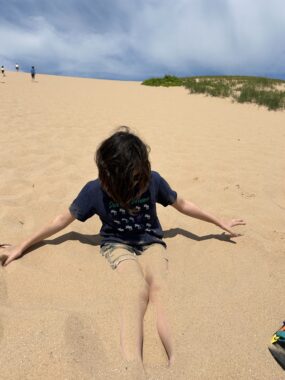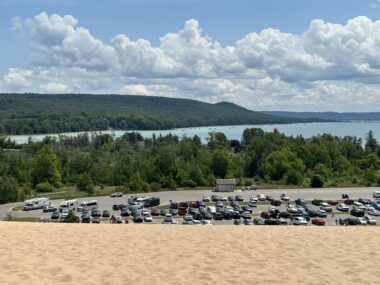Learning from my daughter with FA about life’s unique journey
A trip to Sleeping Bear Dunes creates memories and prompts reflection

I’m amazed at how many lessons my daughter teaches me just by being herself.
We were at the base of Sleeping Bear Dunes in Michigan, an eight-hour drive from our home in Ohio. It was hot out, and the sun’s reflection on the sand made it even hotter.
Because Friedreich’s ataxia (FA) continues to progress in my daughter’s life, we must be more intentional about the vacations we take. Amelia, 11, was diagnosed with FA three years ago, although we had witnessed symptoms in her long before we learned what was causing them.
Before we arrived, we debated whether we should visit the dunes. The location is hot and steep, and it requires climbing a large dune and several smaller ones that stretch off into the distance. At the end of the day, our concerns were no match for Amelia’s love of sand.
Staring up at the peak from the bottom of the dunes, Amelia turned down offers of transportation. She didn’t want to be carried up the hill, nor did she want a piggyback ride from a winded adult. “It’s OK, I’ll stay here,” she said with a shrug. Then she began digging in the sand and burying her legs.

Amelia buries herself in the sand at Sleeping Bear Dunes in Michigan. (Photo by Elizabeth Hamilton)
A moment of reflection
As I helped Amelia cover her lower extremities, my mind wandered. I chuckled as I thought about what my car would look like later. I watched other people scale the sandy dunes and noticed the differences around us. Some ran up while others struggled with every step. Some stopped to calm sobbing children or looked like they might start crying themselves. Others paused to take selfies. Some stopped at the first peak, while others continued to the next. All of these people were at different places on their journeys, facing unique barriers.
I think the same can be said about those of us on an FA journey. We are at a unique moment in history. With last February’s approval by the U.S. Food and Drug Administration of Skyclarys (omaveloxolone), some FA families can breathe a sigh of relief at finally gaining access to a treatment. Others are fighting for insurance coverage. Still others face uncertainty due to their age or where they live.
Most of us used to be in a similar place: facing the journey with no access to treatment apart from clinical trials. Now we find ourselves in different places with varying resources. Many who struggled up the hill before us are no longer with us. As I contemplated all of this, I felt loss, excitement, frustration, hope, and gratitude, all at the same time.
I was so lost in my thoughts I didn’t notice that Amelia was on the move.
Climbing the hill
I heard the commotion before I saw what was happening. Amelia had decided to climb Sleeping Bear Dunes while a friend cheered her on. Unable to walk in the sand, she was on all fours, crawling up the hill. I protested at first, wanting to pick her up and carry her. But Amelia, who has a stubborn streak, kept repeating, “I got this, Mom.” She took breaks but never gave up. With the sun beating down and the wind whipping across the sand, she took on the Sleeping Bear.
When we got to the top of the first big hill, Amelia rolled over and looked out. She was breathing heavily but smiling even harder as we all congratulated her. She could see the water in the distance and tiny vehicles the size of Matchbox cars below. No one else was crawling up the dunes, reaffirming that every path we take is unique.
The trip down was easier than the trip up. Amelia giggled and chatted with her sister and friends as she scooted down. Once everyone was loaded in the car, the air conditioning was a welcome relief.
As we drove down the road, my phone buzzed with a text and then a photo. One of my dear friends, who had been battling with an insurance company, was holding his Skyclarys prescription. Amelia is still waiting for her eligibility, but the joy I had for my friend in that moment was so overwhelming that I cheered.
That’s one more person who just cleared the first dune.

Amelia’s view from the first peak. (Photo by Elizabeth Hamilton)
Note: Friedreich’s Ataxia News is strictly a news and information website about the disease. It does not provide medical advice, diagnosis, or treatment. This content is not intended to be a substitute for professional medical advice, diagnosis, or treatment. Always seek the advice of your physician or another qualified health provider with any questions you may have regarding a medical condition. Never disregard professional medical advice or delay in seeking it because of something you have read on this website. The opinions expressed in this column are not those of Friedreich’s Ataxia News or its parent company, Bionews, and are intended to spark discussion about issues pertaining to Friedreich’s ataxia.








Leave a comment
Fill in the required fields to post. Your email address will not be published.